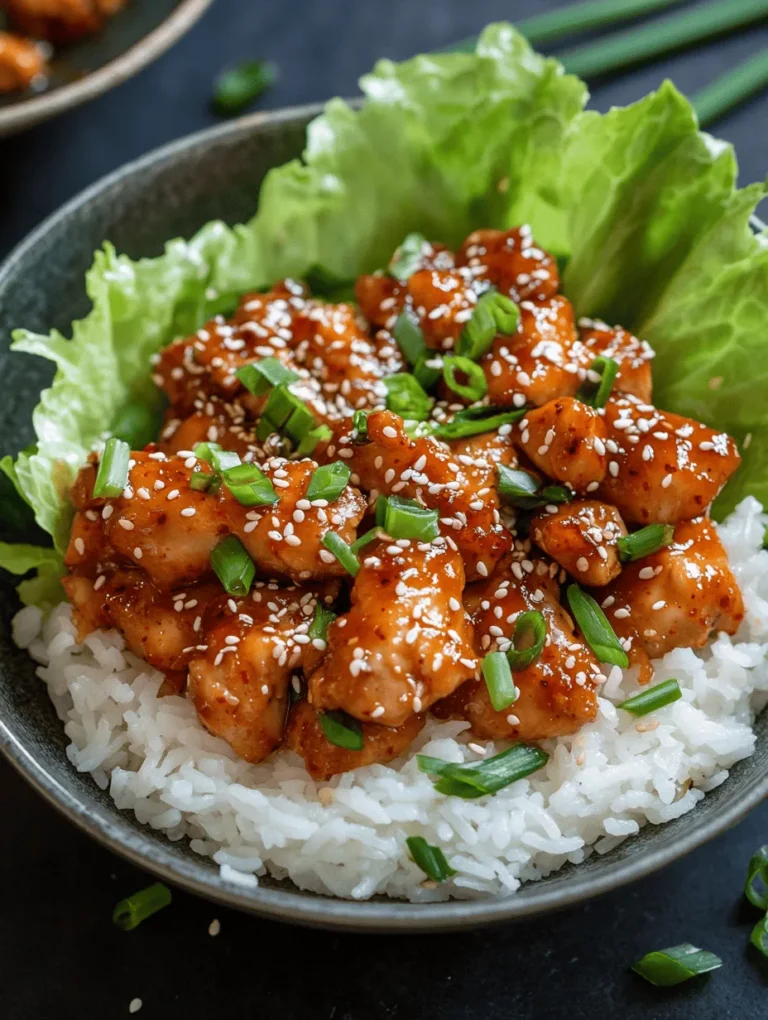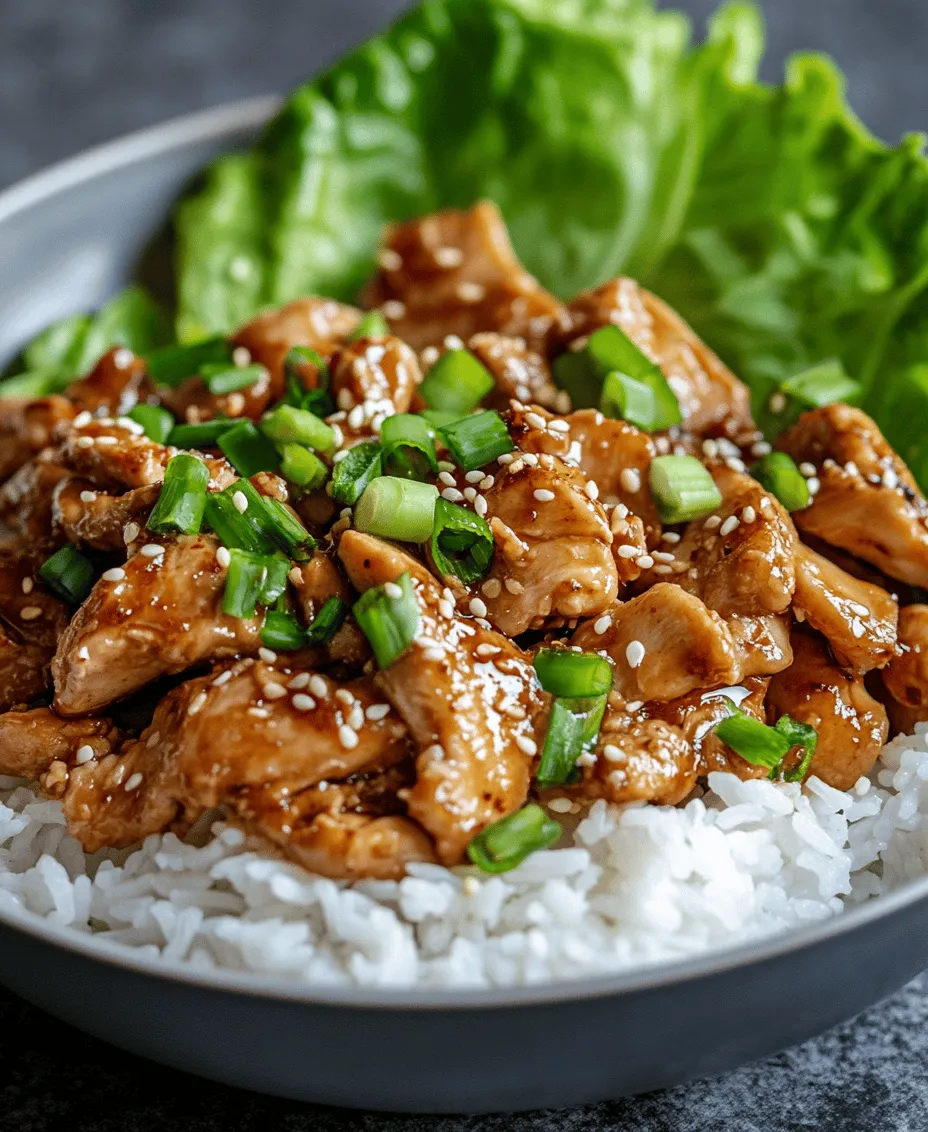Introduction
Korean cuisine is celebrated for its vibrant flavors, diverse textures, and a harmonious balance of sweet, savory, spicy, and tangy elements. It offers an inviting blend of dishes that not only tantalize the taste buds but also reflect a rich cultural heritage. Among these culinary gems, bulgogi stands out as a quintessential dish, representing the heart of Korean cooking. The term “bulgogi” translates to “fire meat,” aptly describing the method of cooking marinated beef over an open flame. However, its appeal transcends traditional boundaries, making it a beloved dish not only in Korea but also across the globe.
Bulgogi has gained immense popularity, becoming a staple in Korean restaurants worldwide. Its delicious marinade, which combines sweet, savory, and slightly spicy notes, brings out the natural flavors of the meat, making it a favorite among food enthusiasts. While the classic version often features beef, chicken bulgogi has emerged as a delightful alternative that is both accessible and easy to prepare for home cooks. In this article, we will introduce you to our recipe for Savory Chicken Bulgogi Delight—a simple yet flavorful take on this classic dish that promises to impress your family and friends alike.
Understanding Bulgogi: A Korean Culinary Tradition
At its core, bulgogi is a dish that highlights the beauty of marinated meat. Traditionally made with thinly sliced beef, the marinade typically includes soy sauce, sugar, sesame oil, garlic, and pepper, creating a perfect balance that enhances the meat’s natural flavors. The combination of these ingredients not only infuses the meat with a rich umami taste but also tenderizes it, resulting in a juicy and flavorful dish.
While beef and pork are the more common meats used in traditional bulgogi recipes, chicken has gained recognition as a lighter and equally delicious option. Choosing chicken for our Savory Chicken Bulgogi Delight not only caters to those who prefer poultry but also offers a quicker cooking time, making it ideal for busy weeknight dinners. The versatility of bulgogi allows for various adaptations, and using chicken provides a unique twist while maintaining the essence of this beloved dish.
Culturally, bulgogi holds a special place in Korean meals and gatherings. It is often enjoyed during festive occasions, family celebrations, and barbecues, symbolizing warmth and togetherness. The act of grilling bulgogi is not just about the meal itself but also about the shared experience of cooking and enjoying food together. This tradition adds to the dish’s charm, making it a delightful choice for gatherings, whether intimate dinners or larger celebrations.
Ingredients Breakdown
To create a mouthwatering Savory Chicken Bulgogi Delight, you’ll need a few key ingredients that work together to develop the dish’s signature flavor. Each ingredient plays a vital role, contributing to the overall taste and experience of the dish.
Boneless Chicken Thighs
Using boneless chicken thighs is essential for this recipe. Unlike chicken breasts, thighs are more flavorful and juicy, thanks to their higher fat content. This richness allows the meat to soak up the marinade beautifully, resulting in a tender and succulent dish. Additionally, the dark meat of chicken thighs holds up well during cooking, making them less likely to dry out compared to their white meat counterparts. If you prefer, you can also use chicken breasts, but be sure to monitor the cooking time closely to prevent overcooking.
Soy Sauce
Soy sauce is a fundamental ingredient in bulgogi marinades, providing the essential umami flavor that defines the dish. It acts as a salt substitute, enhancing the overall taste profile without overpowering the other flavors. When selecting soy sauce, consider using a low-sodium variety if you are mindful of salt intake. This allows you to control the seasoning while still achieving that rich, savory flavor that enhances the chicken.
Gochujang
One of the standout ingredients in this recipe is gochujang, a traditional Korean red chili paste made from fermented soybeans, glutinous rice, and red chili powder. Gochujang adds a unique depth of flavor, incorporating a mild heat and a slight sweetness that perfectly complements the other marinade ingredients. It is a staple in Korean cooking and can be found in most Asian grocery stores or online. If you can’t find gochujang, you can substitute it with a mixture of red pepper flakes and a touch of honey or sugar, but the flavor won’t be quite the same.
Brown Sugar
Brown sugar serves to balance the savory and spicy elements of the marinade, contributing a touch of sweetness that enhances the overall flavor. It caramelizes beautifully when cooked, adding a delightful glaze to the chicken. If you’re looking for alternatives, you can use honey or maple syrup, though you may need to adjust the quantities slightly to achieve the desired sweetness.
Sesame Oil
Sesame oil is another vital component, providing a distinct nutty aroma that elevates the dish. This oil is often used in Korean cuisine to enhance flavors and add richness. When selecting sesame oil, opt for toasted sesame oil for its robust flavor. A little goes a long way, so just a teaspoon or two will suffice to impart that signature taste.
Suggested Substitutes
For those with dietary restrictions or specific preferences, there are several substitutes you can use in this recipe. For instance, if you’re looking to reduce sodium, consider using tamari or coconut aminos in place of soy sauce. For a gluten-free option, ensure that your soy sauce is labeled gluten-free, or use tamari, which is naturally gluten-free. Additionally, those who are vegan can experiment with tofu or tempeh as a protein substitute, ensuring to adjust marinating times accordingly as these proteins absorb flavors differently than chicken.
Preparation Steps: Marinating and Cooking
Now that we’ve covered the key ingredients, let’s dive into the preparation steps, starting with the marinating process. Marinating is a crucial step in achieving the rich flavors and tender texture that bulgogi is known for.
Marinating Process
1. Combine the Marinade Ingredients: In a mixing bowl, combine soy sauce, gochujang, brown sugar, sesame oil, minced garlic, and black pepper. Whisk the ingredients together until the sugar is fully dissolved, creating a flavorful marinade.
2. Prepare the Chicken: Cut the boneless chicken thighs into thin strips or bite-sized pieces. This not only allows for quicker cooking but also ensures that the chicken absorbs the marinade effectively.
3. Marinate the Chicken: Place the chicken pieces in a resealable plastic bag or a glass container and pour the marinade over the top. Seal the bag or cover the container, ensuring the chicken is well-coated in the marinade. For optimal flavor absorption, refrigerate the chicken for at least 30 minutes. However, if you have more time, marinating for 2 to 4 hours—or even overnight—will yield the best results.
4. Resting the Marinade: While marinating, it’s essential to let the flavors meld. The sugars will help tenderize the meat while the soy sauce and gochujang infuse it with rich flavor.
By following these preparation steps, you’ll be well on your way to creating a delicious Savory Chicken Bulgogi Delight that will impress everyone at your table. In the next part of the article, we’ll explore the cooking methods and tips for achieving the perfect bulgogi, ensuring that your dish turns out flavorful and satisfying. Stay tuned for more culinary insights and tips on how to serve this delightful dish!
Cooking Method
To prepare the Savory Chicken Bulgogi Delight, you can choose between a skillet or a grill pan. Both methods yield delicious results, but understanding the nuances of each will help you achieve the best flavor and texture. When cooking bulgogi, the goal is to achieve a perfect balance of tenderness and caramelization, which will elevate your dish to restaurant-quality levels.
How to Achieve the Perfect Caramelization of the Chicken
To achieve that signature caramelization, start by ensuring that your skillet or grill pan is preheated. The ideal cooking temperature for bulgogi is medium-high heat. When the pan is hot enough, add a splash of oil (preferably sesame oil for an authentic flavor) to prevent sticking and enhance the richness of the dish.
Once the oil shimmers, add your marinated chicken slices in a single layer. Avoid overcrowding the pan, as this will trap moisture and steam the chicken instead of searing it. Cook the chicken for about 3-4 minutes on one side, undisturbed, to develop a caramelized crust before flipping. Continue to cook for an additional 2-3 minutes until the chicken is fully cooked and has a beautiful golden-brown color.
For an extra layer of flavor, consider adding a splash of the leftover marinade to the pan during the last minute of cooking. This will create a sticky glaze that enhances the overall taste of the dish. Once cooked, let the chicken rest for a few minutes to allow the juices to redistribute before serving.
Tips for Using a Skillet or Grill Pan Effectively
1. Use the Right Pan: A cast-iron skillet or a non-stick grill pan is ideal for achieving that sought-after sear. The heavy bottom of cast iron retains heat well, while a non-stick surface can make for easier cleanup.
2. Preheat Thoroughly: Always preheat your pan before adding oil and chicken. A hot pan ensures that the chicken sears rather than steams.
3. Cook in Batches: If you’re making a large quantity, cook the chicken in batches. This prevents overcrowding, which can lead to uneven cooking.
4. Don’t Skip the Marinade: The marinade not only infuses flavor but also helps tenderize the chicken. Allow the chicken to marinate for at least 30 minutes, or, for best results, overnight in the refrigerator.
5. Adjust Heat as Needed: If you notice the chicken is browning too quickly, reduce the heat slightly to ensure it cooks through without burning.
Garnishing for Texture and Presentation
Once your chicken is cooked to perfection, it’s time to elevate its presentation. Garnishing is not just for aesthetics; it also enhances the dish’s texture and flavor profile. Sprinkle toasted sesame seeds over the top to add a nutty crunch. The seeds provide a lovely contrast to the tender chicken and contribute to the dish’s authentic Korean essence.
Additionally, finely sliced green onions (scallions) add a fresh, vibrant note that balances the savory richness of the bulgogi. The combination of sesame seeds and green onions not only beautifies the dish but also introduces layers of flavor that will delight your palate.
Serving Suggestions
Savory Chicken Bulgogi Delight is incredibly versatile and can be enjoyed in several delightful ways that embody the essence of Korean cuisine.
Serving with Steamed Rice
In traditional Korean meals, rice serves as the cornerstone. Steamed white or brown rice is the perfect accompaniment to bulgogi, absorbing the flavorful juices and balancing the dish’s savory notes. To serve, spoon a generous portion of the bulgogi over a mound of rice, allowing the flavors to meld beautifully. This combination creates a satisfying and wholesome meal that is both filling and delicious.
Using Lettuce Leaves for Wrapping
For a lighter, more health-conscious option, serve the bulgogi with fresh lettuce leaves. This method of wrapping is a popular Korean tradition known as “ssam.” Simply take a piece of lettuce, add a spoonful of bulgogi, and top with a drizzle of ssamjang (a spicy dipping sauce) or a bit of kimchi for an added kick. This not only enhances the flavor but also makes for a fun and interactive dining experience.
Suggesting Complementary Side Dishes
To elevate your meal further, consider serving it alongside traditional Korean side dishes (banchan). Kimchi is a staple that pairs beautifully with bulgogi, adding a tangy contrast that enhances the overall dining experience. Other excellent choices include pickled vegetables (like pickled radish), seasoned soybean sprouts, or a simple cucumber salad. These sides not only provide variety but also contribute to a balanced meal.
Nutritional Benefits of Chicken Bulgogi
Savory Chicken Bulgogi Delight boasts a nutritious profile that makes it a fantastic meal option. Chicken is an excellent source of lean protein, essential for muscle building and repair. The marinade, which includes ingredients like soy sauce, garlic, and ginger, contributes antioxidants and anti-inflammatory properties, making this dish not only tasty but also beneficial to your health.
In terms of nutrition, a serving of chicken bulgogi is relatively low in calories, especially when paired with vegetables and served without heavy sauces. If you’re looking for gluten-free options, simply substitute regular soy sauce with tamari or coconut aminos, which maintain the flavor without the gluten content.
Moreover, incorporating vegetables into your bulgogi will further enhance its health benefits. Adding bell peppers, carrots, or onions not only increases the fiber content but also introduces a variety of vitamins and minerals. This means you can enjoy a delicious meal while also nourishing your body with essential nutrients.
Cultural Significance and Variations of Bulgogi
Bulgogi holds a special place in Korean culture, tracing its roots back to the Goguryeo era (37 BC – 668 AD). Originally known as “maekjeok,” it consisted of marinated meat grilled over an open flame. Over time, the recipe evolved, and today, bulgogi is synonymous with tender marinated beef, chicken, or pork, cooked quickly at high temperatures for a rich flavor.
Each region in Korea has its own take on bulgogi. For instance, in the southern regions, you might find a sweeter marinade that incorporates fruits like pear or apple for a caramelized finish. In contrast, northern variations may lean towards a spicier profile, using gochujang (Korean chili paste) to add heat.
Modern adaptations of bulgogi have also surfaced, with cooks integrating bulgogi flavors into tacos, sandwiches, and even pizza. This fusion approach showcases the versatility of bulgogi, allowing it to transcend cultural boundaries while maintaining its fundamental essence.
Conclusion
Savory Chicken Bulgogi Delight is more than just a meal; it’s a celebration of Korean culinary traditions that brings people together. The ease of preparation combined with the rich, savory flavors makes it a fantastic dish for family gatherings or casual weeknight dinners.
Sharing this dish with loved ones not only fosters a communal dining experience but also introduces them to the vibrant world of Korean cuisine. As you experiment with this recipe, don’t hesitate to explore variations and incorporate your personal touch. Whether you embrace traditional serving methods or innovate with modern twists, the joy of cooking and sharing bulgogi will surely enrich your culinary journey. So gather your ingredients, fire up the skillet or grill pan, and enjoy a delightful taste of Korea right in your home!



